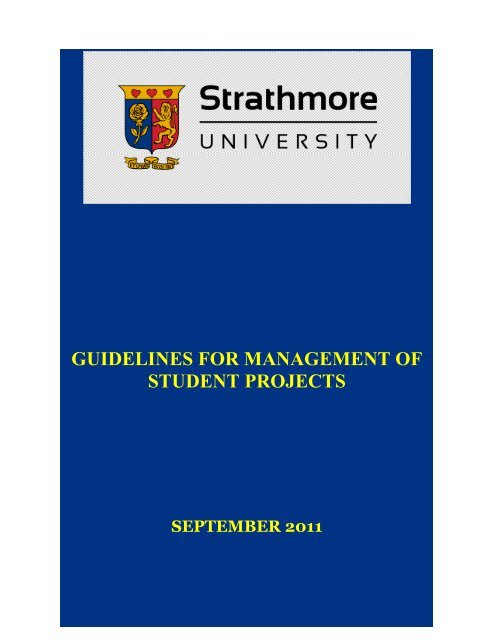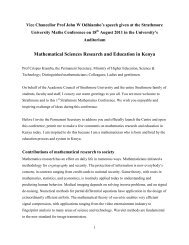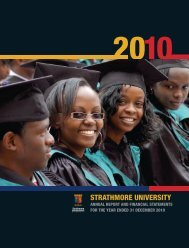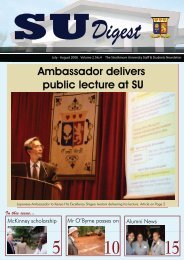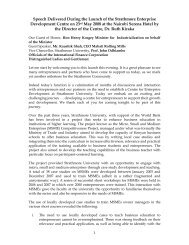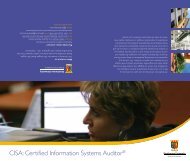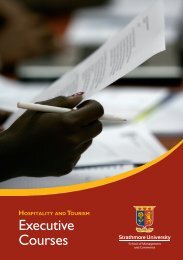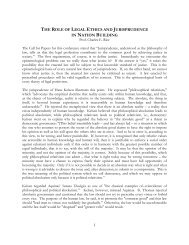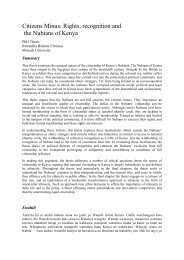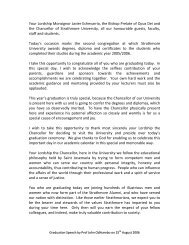guidelines for management of student projects - Strathmore University
guidelines for management of student projects - Strathmore University
guidelines for management of student projects - Strathmore University
Create successful ePaper yourself
Turn your PDF publications into a flip-book with our unique Google optimized e-Paper software.
GUIDELINES FOR MANAGEMENT OFSTUDENT PROJECTSSEPTEMBER 2011
Table <strong>of</strong> Contents1 INTRODUCTION ................................................................................................................... 32 IDENTIFICATION AND ALLOCATION OF PROJECTS ................................................... 33 TYPES OF PROJECTS ........................................................................................................... 44 UNDERTAKING THE PROJECT ......................................................................................... 65 MAINTAINING A SUCCESSFUL SUPERVISOR-STUDENT RELATIONSHIP .............. 96 RESEARCH PROJECT PROPOSAL FORMAT .................................................................. 127 DOCUMENTATION OF SOURCES ................................................................................... 238 APPENDICES ....................................................................................................................... 249 PLAGIARISM IN RESEARCH PROJECT .......................................................................... 2510 SUBMISSION OF THE PROJECT ...................................................................................... 2611 ASSESSMENT ...................................................................................................................... 2812 SUBMISSION/RE-SUBMISSION OF THE PROJECT ....................................................... 3213 REVIEW OF PROJECTS ...................................................................................................... 32APPENDIX 1 PROJECT TITLE APPROVAL FORM ........................................................... 33APPENDIX 2 PROJECT PROGRESS LOG ........................................................................... 35APPENDIX 3 TITLE PAGE .................................................................................................... 36APPENDIX 4 ................................................................................................................................ 37
General enquiries about the organization <strong>of</strong> <strong>projects</strong> should be addressed to the ProjectCoordinator whereas specific enquiries about individual <strong>projects</strong> should be directed to theSupervisor.The Project Coordinator/Dean should ensure that all academic staff <strong>of</strong> the relevant Unit gets afair share <strong>of</strong> the number <strong>of</strong> <strong>projects</strong>. The number <strong>of</strong> <strong>projects</strong> allocated to an academic staff <strong>of</strong>any Faculty/School/Institute shall be limited to a maximum (to be determined by the faculty)irrespective <strong>of</strong> whether they are individual or group <strong>projects</strong>. For co-supervised <strong>projects</strong>, thesupervision load will be considered as half <strong>for</strong> each supervisor. Any supervision in excess <strong>of</strong>maximum <strong>projects</strong> should be approved by the Dean <strong>of</strong> Faculty.Each <strong>student</strong> will be allocated a Supervisor. The number <strong>of</strong> supervisor per project shall berestricted to a maximum <strong>of</strong> two.3 TYPES OF PROJECTSThere are two types <strong>of</strong> <strong>projects</strong>;i. Projects Proposed by StudentsFor <strong>projects</strong> proposed/identified by <strong>student</strong>s, the latter are required to discuss the proposal withpotential Supervisors from within or outside the department. The project title has to be approvedby the Supervisor(s) and the Department.Students are required to submit a proposal <strong>of</strong> the project, which should include the followingminimum in<strong>for</strong>mation:1. Project Title2. Problem Statement3. Literature Review4. Research MethodologyThe proposal should be signed by the Supervisor(s) and submitted to the Project Coordinator bythe end <strong>of</strong> the first semester <strong>of</strong> the final year <strong>for</strong> <strong>student</strong>s’ defense..
After approval by the department, a final list <strong>of</strong> <strong>projects</strong> with the names <strong>of</strong> supervisors and<strong>student</strong>s prepared by the Project Coordinator is affixed on the Faculty/ School/Institute NoticeBoard(s).ii. Projects proposed by academic staff or other supervisorsThe Dean requests all academic staff concerned to submit a list <strong>of</strong> project titles to the ProjectCoordinator.A list <strong>of</strong> project titles available <strong>for</strong> the degree course is then prepared by the Project Coordinatorwith the input provided by the academic staff and potential supervisors.Students are given the opportunity to meet the supervisors to be in<strong>for</strong>med about the various<strong>projects</strong> proposed. Interested <strong>student</strong>s are thereafter requested to submit their choices to theProject Coordinator in one-two weeks’ time.Based on <strong>student</strong>s’ choices, the <strong>projects</strong> are allocated by the Project Coordinator. After approvalby the Faculty/ School/Institute, a final list <strong>of</strong> <strong>projects</strong> with the names <strong>of</strong> supervisors and<strong>student</strong>s prepared by the Project Coordinator is affixed on the Faculty/ School/InstituteNotice Board(s).This should be done three weeks after commencement <strong>of</strong> a semester.If there are difficulties in allocating <strong>projects</strong>, a departmental meeting is called to thrash out thematter.NB Students should be encouraged as far as possible to come up with their own <strong>projects</strong>.The two main criteria that must drive a project proposal are:o Feasibility <strong>of</strong> the project (time, supervision, cost implication, availability <strong>of</strong>equipment and literature as well as likelihood <strong>of</strong> accessing expected data.)o Academic challenge
4 UNDERTAKING THE PROJECTThe project coordinator will issue the program <strong>of</strong> activities, allocation, supervisor, defense,submission and penalties.Students are normally expected to start working on the project after the allocation.The Students copy <strong>of</strong> the Project Title Approval Form serves as a record <strong>of</strong> the Supervisor’sapproval <strong>of</strong> the Project Title. It gives the <strong>student</strong> a green light to start the project proposal whichshould be submitted at the end <strong>of</strong> the semester.Students should also fill in the Project Progress (In s<strong>of</strong>t copy) It serves as a record <strong>of</strong> the<strong>student</strong>’s meeting with the supervisor. Its purpose is to help the <strong>student</strong> plan their own projectand to record the outcomes as well as gaining valuable skills. The <strong>student</strong> will find that thein<strong>for</strong>mation accumulated in this <strong>for</strong>m will prove helpful during the write up <strong>of</strong> the project. Thedocument belongs to the <strong>student</strong> and it is their responsibility to keep it up to date and to ensuretheir supervisor is aware <strong>of</strong> the project activities they have undertaken.Both the <strong>student</strong> and the supervisor should retain a copy <strong>of</strong> the document. A copy <strong>of</strong> the dulyfilled and signed Log Book should be submitted concurrently with the Project.4.1 Responsibilities <strong>of</strong> the supervisorEach project will be supervised by an academic staff, either full-time or part-time. Some <strong>projects</strong>,due to their inherent nature (e.g. multidisciplinary) may be supervised by a maximum <strong>of</strong> twosupervisors.A supervisor should normally not be appointed <strong>for</strong> the project <strong>of</strong> a <strong>student</strong> who is directly relatedto him/her to ensure impartiality. The onus to declare any such relation with a final year <strong>student</strong>rests with the supervisor. In case there is divergence, the Dean/Director will be called toarbitrate.The supervisor(s) shall monitor, support and direct the <strong>student</strong>’s work and progress soon after theallocation <strong>of</strong> project titles.
The responsibilities <strong>of</strong> the supervisor include:• Supervising/proposing <strong>projects</strong> in their own subject area;• Briefing the <strong>student</strong>s and appraising them <strong>of</strong> the regulations pertaining to the final year<strong>projects</strong>;• Setting a framework <strong>for</strong> regular scheduled progress meeting between supervisor(s) and<strong>student</strong>;• Giving frequent feedback/comments on progress achieved by the <strong>student</strong>;• Giving guidance about relevant literature on the topic under study and appropriateliterature sources;• Providing advice on issues <strong>of</strong> plagiarism, in line with the <strong>University</strong> Regulations;• Assisting in the identification <strong>of</strong> a research methodology, planning and execution <strong>of</strong> theresearch project (if applicable);• Giving guidance on the approach <strong>for</strong> appropriate analysis <strong>of</strong> data obtained, interpretationand presentation <strong>of</strong> results (if applicable);• Giving guidance about the <strong>for</strong>mulation <strong>of</strong> an appropriate hypothesis-driven researchproject and focusing on the objectives <strong>of</strong> the research (if applicable);• Assisting in the preparation <strong>of</strong> a viable/feasible research proposal (synopsis), inclusive <strong>of</strong>a time schedule and a project costing be<strong>for</strong>e embarking on the study (if applicable);• Providing guidance on issues <strong>of</strong> laboratory safety (if applicable);• Giving guidance on the writing <strong>of</strong> the different chapters <strong>of</strong> the dissertation andcommunicating the standard expected;• Advising on the preparation <strong>of</strong> the oral presentation and/or poster (if applicable).4.2 Responsibilities <strong>of</strong> the <strong>student</strong>Throughout the whole project work, the <strong>student</strong> shall seek advice, comments and guidance fromhis/her supervisor(s) on the nature <strong>of</strong> the project work and standard expected. Students areadvised to keep a notebook <strong>for</strong> the purpose <strong>of</strong> the meeting with supervisor(s) while thesupervisor(s) may wish to keep a brief record <strong>of</strong> each meeting held.
The responsibilities <strong>of</strong> the <strong>student</strong> include:• Adhering to the <strong>University</strong> Regulations <strong>for</strong> Final Year <strong>projects</strong> and any projectGuidelines prepared by the Faculty/School/Institute; reference?• Reading and abiding by the regulations <strong>of</strong> the <strong>University</strong> on Plagiarism and Fabricationor Falsification <strong>of</strong> Result(s)/Document(s); reference?• Arranging with his/her supervisor(s) mutually agreed convenient times to discussprogress achieved (in the event that meetings are not possible, e-mails or other <strong>for</strong>ms <strong>of</strong>communication may be used);• Bringing to the urgent attention <strong>of</strong> the supervisor(s) any problems (academic andpersonal) associated with progress;• Responding to the supervisor’s suggestions and/or criticisms on his/her work andprogress;• Following all library/laboratory safety <strong>guidelines</strong> (if applicable);• Discussing the layout <strong>of</strong> the final project with the supervisor(s) prior to the writing-upstage;• Writing the dissertation on his/her own and planning the writing-up so as to give thesupervisor(s) adequate time to read the preliminary draft copies and to provide guidedand motivated feedback well ahead <strong>of</strong> the submission date;• Adhering to the time schedule specified in the project proposal (synopsis) as agreed withthe supervisor(s);• Working diligently and becoming an independent learner.• Keeping all raw data/questionnaires/survey <strong>for</strong>msIf the <strong>student</strong> is unable to contact his/her supervisor, s/he should contact the Project Coordinator<strong>for</strong> assistance.The onus is on the <strong>student</strong>/s to contact the Project Supervisor regularly <strong>for</strong> discussion andguidance. Failure to do so shall lead to the project being unreceivable by the Faculty.
5 MAINTAINING A SUCCESSFUL SUPERVISOR-STUDENT RELATIONSHIP5.1 Strategies and suggestions <strong>for</strong> individual supervisorsThe quality <strong>of</strong> supervisory relationships is a key factor in the satisfactory completion <strong>of</strong> <strong>student</strong>research project. However, there are enormous variations in this relationship, because <strong>of</strong>differences between disciplines as well as individual differences. Thus, there may be a widevariety <strong>of</strong> appropriate strategies and approaches according to the discipline and the particularsituation. Both the quantity and quality <strong>of</strong> communication between supervisors and research<strong>student</strong>s is significant. Both can help the <strong>student</strong>s reach a successful completion.Different <strong>student</strong>s will want and require different types and amounts <strong>of</strong> interaction, assistance,feedback and direction from the beginning and at different stages. Some <strong>student</strong>s may be ableclearly to articulate their needs and limitations from the beginning and this may assist you towork with them.Throughout the process <strong>of</strong> the research project the relationship will change. You may notice thatat some stage the rational, happy <strong>student</strong>s you started supervising become anxious and angry.They may have periods when they seem quite irrational and unresponsive to suggestion andguidance. It must be noted that this research you are supervising is almost certainly the biggestpiece <strong>of</strong> academic work the <strong>student</strong> has ever undertaken, and may ever undertake. The <strong>student</strong>’sdesire <strong>for</strong> ultimate success and the problems which may appear along the way frequently makelife a strain <strong>for</strong> <strong>student</strong> and supervisor alike.At the start <strong>of</strong> the supervisor-<strong>student</strong> relationship, it is important to discuss other commitments,planned leave, holidays or other work commitments that the supervisor has. This sharing willhelp build trust with each other and lead to more open discussion.It is worth noting that supervising a <strong>student</strong> is like running a class session. There<strong>for</strong>e to complywith some <strong>of</strong> the requirements above, the environment must be conducive to learning.
5.2 Role <strong>of</strong> the Supervisor♦ Discuss and reach agreement with the <strong>student</strong> on details <strong>of</strong> the supervisory arrangements,including a regular meeting schedule. Ensure maintenance <strong>of</strong> the meeting schedule. Discusswhat should be done if someone cannot attend a scheduled meeting. Also discuss access tothe supervisor outside scheduled meetings.♦ Ensure that the <strong>student</strong> is familiar with the policies and administrative arrangements relatingto their studies.♦ Assist the <strong>student</strong> to develop a realistic program <strong>of</strong> study to ensure they complete theirresearch project within the required time♦ Monitor the <strong>student</strong>’s progress♦ If you find the <strong>student</strong> frequently cancelling meetings, it could be an indication <strong>of</strong> problemsthey may be experiencing. Contact the <strong>student</strong> to indicate your concern and set a new meetingtime. Insist on seeing the <strong>student</strong> and emphasize at this meeting that you need tocommunicate regularly. It is worthwhile to reiterate that the purpose <strong>of</strong> the meeting is to helpthe <strong>student</strong> to progress and that lack <strong>of</strong> progress is a cause <strong>for</strong> mutual concern which is notalleviated by avoiding discussion.♦ Keep written documentation about decisions and follow-up activities that stem from eachmeeting.♦ Take up the issue <strong>of</strong> unsatisfactory progress with the Faculty committee to determine whataction should be taken.♦ You and your <strong>student</strong>(s) could then discuss the following issues:• What does supervision mean?• What is involved in the development <strong>of</strong> a research proposal?• What sort <strong>of</strong> feedback will the supervisor give: how <strong>of</strong>ten, how much, what <strong>for</strong>m?• What sort <strong>of</strong> feedback does the <strong>student</strong> prefer/benefit from, find helpful/unhelpful?• What research skills, statistical analysis or other technical skills are required <strong>for</strong> theresearch?Writing the Research Project• What is the appropriate length, structure, and presentation?
Editing• Ensure basic referencing skills are acquired early.• Give detailed feedback by using one or more pages <strong>of</strong> <strong>student</strong>s’ work. Too muchfeedback becomes overpowering and discourages <strong>student</strong>s from learning the principleswhich underpin the corrections.• Indicate to supervised <strong>student</strong>s at the beginning your approach to analysis and t<strong>of</strong>eedback on their written work.5.3 Role <strong>of</strong> the Student♦ The <strong>student</strong> should take responsibility <strong>for</strong> the design, methodology and presentation <strong>of</strong> theproject.♦ It is the responsibility <strong>of</strong> the <strong>student</strong> to edit their work, and ensure all in<strong>for</strong>mation is accurateand complete.♦ The <strong>student</strong> is responsible <strong>for</strong> presenting their research proposal to the Faculty <strong>for</strong> approvalbe<strong>for</strong>e embarking on the data collection.♦ Students are reminded that their research project must be their own work and all quotationsfrom other sources, whether published or unpublished, must be properly acknowledged.Plagiarism is a very serious <strong>of</strong>fence and, where proven against a <strong>student</strong>, may result indisqualification from the examination <strong>of</strong> the project. Would this lead to disqualification fromuniversity? Starting a new project? Unclear ….♦ The <strong>student</strong> should submit material in sufficient time to allow <strong>for</strong> comment and discussionbe<strong>for</strong>e proceeding to the next stage.♦ The <strong>student</strong> takes responsibility <strong>for</strong> maintaining regular contact with the supervisor.♦ The <strong>student</strong> should participate in the progress reports to demonstrate their commitment tocompleting the project in time.♦ The <strong>student</strong> takes responsibility <strong>for</strong> incorporating supervisor’s comments and feedback intotheir work, and seeking clarification where necessary.♦ Students should keep track <strong>of</strong> their project to ensure it progresses according to the timeframe. Where deviations are observed, they should be brought to the attention <strong>of</strong> the
supervisor as soon as possible.♦ Any problems encountered in conducting the project should be brought to the attention <strong>of</strong> thesupervisor as soon as possible after they occur so that remedial action can be takenimmediately.Any problem encountered by the <strong>student</strong> during the project should be discussed with thesupervisor(s). If the matter cannot be resolved, it should be reported to the Project Coordinatorand eventually to Dean <strong>of</strong> Faculty/Director <strong>of</strong> School/Institute.6 RESEARCH PROJECT PROPOSAL FORMATA proposal is a statement <strong>of</strong> intention outlining an issue <strong>of</strong> concern to be investigated within thecontext <strong>of</strong> a research question/objectives.A research proposal should indicate;• What will be researched• Why will that be researched• In which manner the research will be executed• Which conceptual framework will be conducted• What are the research objectives• What are the expected outcomesA good research proposal helps the researcher to approach the research in a systematic manner.6.1 Format and Type RequirementsCover and bindingThe project shall be spiral-bound with a protective plastic front cover and a stiff card back-cover.Paper and typographical detailThe project must be typed, justified and printed on one side <strong>of</strong> the paper only using:• 1½ line spacing, and
• Characters not less than 12pt, font type ‘Times New Roman and 14 pt <strong>for</strong> main titles.Good quality A4 white paper should be used <strong>for</strong> the printing and <strong>for</strong> xerographic copies.The left margin used <strong>for</strong> binding shall not be less than 40 mm while all other margins shall not beless than 20 mm.PaginationPages shall be numbered consecutively throughout the project, starting with the title page,including appendices. Roman numerals (i, ii, iii..) shall be used <strong>for</strong> the front pages(Preliminaries) and Arabic numerals (1, 2, 3, …) as from the ‘Introduction’ section onwards.Page numbers shall be located centrally at the bottom <strong>of</strong> the page, approximately 10 mm abovethe edge. If there is more than one volume, each volume shall have its own pagination.Length, Spacing and Font SizeThe length <strong>of</strong> the research project report should be approximately 10,000 words or minimum 30pages excluding references and appendices. One and a half (1 ½) line spacing and a standard fontsize <strong>of</strong> 12 should be used <strong>for</strong> the text and front matter materials except <strong>for</strong> the title page andtables where different line spacing and fonts may be used. The final document should be <strong>of</strong> laserprint quality. The print quality should be dark and clean.MarginsThe margins throughout the report or manuscript should be at least 25mm or 1 inch on the right,top and bottom. The left hand margin must be set to 30mm or 1¼ inches to allow <strong>for</strong> binding.Larger tables may be typed in smaller fonts in order to maintain standard margins.Numbers and PercentagesNumbers in text should be typed in “Arabic numbers”. For example chapter 1, table 2 or figure3. A sentence cannot begin with a number. A number beginning a sentence must be spelt out inwords. For example: “Twenty-five <strong>of</strong> the union representatives rejected the employer’s <strong>of</strong>fer”.Similarly, percentages should be written in words when they begin a sentence. For example,
“Sixty-five percent <strong>of</strong> the senior managers in the company were local citizens while 35 percentwere <strong>for</strong>eigners”.Research project reports should consist <strong>of</strong> preliminaries, main text and references/appendices.6.1.1 PreliminariesThe front matter or preliminary pages <strong>of</strong> a research project should be paginated appropriatelywith small Roman numbers at the bottom center <strong>of</strong> the page.The preliminaries should abide by the following order, wherever applicable: Title PageThe title page <strong>of</strong> the project proposal shall give the following in<strong>for</strong>mation in the order listed:o Full title <strong>of</strong> the project as approved by the Department/Faculty/Institute;o The full name <strong>of</strong> the author;o Researchers registration number;oo The qualification <strong>for</strong> which the project is submitted;o The name <strong>of</strong> the institution to which the project is submitted;o The Department Faculty/Institute in which the project is to be submitted; ando The month and year <strong>of</strong> submission. Table <strong>of</strong> ContentsThe Table <strong>of</strong> Contents shall list in sequence with page numbers all chapters, sections/headings,sub-sections/headings and other sub-divisions <strong>of</strong> the project, appendices, etc. List <strong>of</strong> Tables, Figures, Plates/SchemesSeparate lists <strong>of</strong> each, in the above order, giving number and page reference. AcknowledgementsAll persons (e.g. supervisor, technician, friends, relatives) and organization/authoritieswho/which have helped in the realization <strong>of</strong> the project shall be acknowledged. Project Declaration FormThe <strong>for</strong>m should be duly filled and it should be included just after the acknowledgement in theproject. Abstract
The abstract is required with all research <strong>projects</strong>. The purpose <strong>of</strong> the abstract is to provide aclear and concise summary <strong>of</strong> the:• Objectives• Scope <strong>of</strong> the project• Methodology used• Major findings and conclusions• Major recommendations or suggestions <strong>for</strong> improvementThe abstract should be approximately 300 words. It should be prepared after the three chapters <strong>of</strong>the proposal or after five chapters the project report have been written but presented as frontmatter material in terms <strong>of</strong> sequence. List <strong>of</strong> AbbreviationsThis section should list in alphabetical order all abbreviations used in the project.6.1.2 Main TextResearch <strong>projects</strong> follow a five-model chapter. The major sections in the five-model chapterinclude:• Chapter 1: Introduction• Chapter 2: Literature Review• Chapter 3: Methodology• Chapter 4: Results or Findings• Chapter 5: Discussion, Conclusions and Recommendations.In addition to the five major sections, a research project should include reference orbibliography, and appendix <strong>for</strong> data collection instruments and other relevant materials used inthe study.Any table, figure, plate, scheme or illustration included in the project should be clearly labeled.The caption should be placed at the top <strong>of</strong> tables but below figures/plates/schemes/illustrations.
Chapter 1: IntroductionChapter 1 serves to introduce the problem and the purpose <strong>of</strong> the study. It acquaints the readerwith the problem. The following areas <strong>of</strong> discussion are frequently included as subsections in theintroduction chapter.• Background <strong>of</strong> the problem• Statement <strong>of</strong> the problem• Purpose <strong>of</strong> the study or general objective• Research questions or specific objectives or hypotheses• Importance or justification or rationale <strong>of</strong> the study• Scope and limitations <strong>of</strong> the study• Definition <strong>of</strong> terms• Chapter summaryBackground <strong>of</strong> the Problem: In this section, the researcher defines the context <strong>of</strong> the study byproviding a brief discussion <strong>of</strong> key theoretical approaches and findings reported in earlier relatedstudies. Trends related to the problem, unresolved issues and social concerns are discussed.Authoritative sources or citations should be provided in the section.Statement <strong>of</strong> the Problem: The problem statement describes the need <strong>for</strong> the research project interms <strong>of</strong> the knowledge gap to be filled. The researcher should present a clear and precisestatement that indicates the gap that previous research studies have not addressed. Authoritativesources or citations should be used to support the problem statement.Purpose <strong>of</strong> the Study or General Objective: In this section the major research objective isaddressed. The purpose statement should emphasize practical outcomes or products <strong>of</strong> the study.For example, “The purpose <strong>of</strong> this study was to determine (measure, examine, or evaluate) factorthat influence entrepreneurial behavior in family businesses”.Research Questions or Specific Objectives or Hypotheses: Specific research questions to beanswered or specific objectives to be investigated should be stated. Either the research questions
or specific objectives may be stated. However, most <strong>of</strong>ten research questions are preferred. Theresearch questions need to be broad enough to allow further breakdown into questionnaire orinterview guide items <strong>for</strong> the data collection. On the average 3-5 research questions aresufficient. The hypothesis should be stated if the study involves experimental designs orstatistical tests.Importance or Justification or Rationale <strong>of</strong> the Study: In this section the researcher describesthe values or the benefits that will accrue from doing the study. The significance <strong>of</strong> the study isconcerned with the relevance <strong>of</strong> the problem both to the practice and theory. That is, does thestudy explore an important question, meet a recognized need or make a useful contribution topractice and theory. Much value is placed on doing research, which has primary value <strong>for</strong> thesolution <strong>of</strong> practical oriented business problems.Chapter Summary: A synopsis <strong>of</strong> the major contents <strong>of</strong> chapter one including the purpose,justification, and scope should be presented. A brief description <strong>of</strong> the remaining chapters <strong>of</strong> theproject should also be provided at this stage.Chapter 2: Literature ReviewThe literature review section should present a review <strong>of</strong> the literature related to the problem orpurpose <strong>of</strong> the study. The section should there<strong>for</strong>e be organized or structured according to theresearch questions or specific objectives in order to ensure relevance to the research problem.The literature review examines recent (at most 10 years) research studies, company data orindustry reports that act as a basis <strong>for</strong> the proposed study. Literature review is meant to give thereader an overview <strong>of</strong> previous relevant contributions to the problem so that they can betterunderstand the research problem and methodology to be used in the study.Specifically, the purpose <strong>of</strong> literature review is to:• Help eliminate duplication <strong>of</strong> what has been done.• Provide a clear understanding <strong>of</strong> existing knowledge base in the problem area.
The literature review should be based on authoritative, recent, and original sources such asjournals, books, thesis or dissertations. The section should end with a summary <strong>of</strong> the importantaspects discussed.Chapter 3: MethodologyResearch methodology section describes the methods and procedures used to carry out the study.This is an important section, which has direct influence on the findings <strong>of</strong> the study. Hence, themethodology used should be described very clearly so that another researcher can follow theprocedures used to reach similar conclusions without difficulty. The methodology chaptershould include the following subsections:• Introduction• Research design• Population• Sampling methods• Data collection methods• Research procedures• Data analysis methods• Chapter summaryIntroduction:The chapter should start with a brief introduction highlighting the generalmethodology and organization or structure <strong>of</strong> the chapter.Research Design: In this section, the researcher should identify, define, and providejustification <strong>for</strong> the specific research design or strategy used in carrying out the study. Researchdesigns include experimental, quasi-experimental, co-relational, causal-comparative, actionresearch, survey, case study or historical.In descriptive studies, survey or case study, the emphasis is placed on defining the design,revealing its merits and providing justification <strong>for</strong> its selection. In experimental or quasiexperimentalstudies, the tests, equipment and control conditions should be described. The
esearcher should also define the dependent and independent variables studied, the proceduresused to examine the variables and steps taken to control <strong>for</strong> extraneous influences that mightthreaten the findings <strong>of</strong> the study.Population and Sampling Designi. PopulationThe researcher should identify and describe the characteristics <strong>of</strong> the population involved in thestudy. Population refers to the entire group <strong>of</strong> people, events, or things <strong>of</strong> interest that theresearcher wishes to investigate. Population <strong>for</strong>ms a basis from which the sample or subjects <strong>for</strong>the study is drawn.ii. Sampling Design and Sample SizeIn this section, detailed description <strong>of</strong> sampling method and the actual sample size should beprovided. The research <strong>student</strong> should clearly identify a relevant sampling frame. Samplingmethods may include probability and non-probability techniques.In non-probability sampling designs, the elements in the population do not have any probabilitiesattached to their being chosen as sample subjects. This means that the findings from the study <strong>of</strong>the sample cannot be confidently generalized to the population. Typical examples <strong>of</strong> nonprobabilitysampling techniques include convenience sampling, and purposive sampling.To ensure fair representation and generalization <strong>of</strong> finding to the general population, probabilitysampling technique should be used. Typical examples <strong>of</strong> probability sampling include simplerandom sampling, systematic sampling, stratified random sampling and cluster sampling. Thesample size should, there<strong>for</strong>e, be representative <strong>of</strong> the general population.Data Collection Methods: In this section, the researcher should describe the major methods <strong>for</strong>collecting data from the subjects. The major methods <strong>for</strong> obtaining data in a study may includeinterviews, questionnaires and observation techniques. The data collection instruments should bedeveloped and organized on the basis <strong>of</strong> the research questions or specific objectives to ensure
elevance to the research problem. A description <strong>of</strong> the instruments should be given, whetherthey are researcher developed or standardized instruments. A description <strong>of</strong> the nature <strong>of</strong>instrument items, validity and reliability, and administration procedures should be provided.Research Procedures: A detailed description <strong>of</strong> the steps taken in the conduct <strong>of</strong> researchshould be provided <strong>for</strong> the purposes <strong>of</strong> replicability. The researcher should provide a completeaccount <strong>of</strong> the research process including pilot testing, scheduling <strong>of</strong> the subjects or participants,distribution and collection <strong>of</strong> the instruments and the running <strong>of</strong> the experiments. Proceduresmay also include timing <strong>of</strong> interviews or questionnaires and instructions given to subjects.Data Analysis Methods: The researcher should identify and describe appropriate data analysismethods <strong>for</strong> the study. Quantitative approaches in terms <strong>of</strong> descriptive statistics or inferentialstatistics should be described.Descriptive statistics include frequencies, measures <strong>of</strong> central tendencies (mean, medium ormode) and measures <strong>of</strong> dispersion (standard deviation, range or variance).Inferential statistics involve measurement or relationships and differences between or among thevariables. Inferential statistics include correlation, regression and analysis <strong>of</strong> variance amongothers.Data analysis tools in terms <strong>of</strong> computer application packages (Excel, SPSS or SAS) should alsobe described. Data presentation methods in terms <strong>of</strong> tables, graphs or charts should also bedescribed in this section. Qualitative data should be summarized and categorized according tocommon themes and presented in frequency distribution tables.Chapter Summary: The methodology chapter should end with a summary or synopsis <strong>of</strong> themain elements discussed in the section.
Chapter 4: Results and FindingsThis is generally the longest section <strong>of</strong> the research project. The objective is to present andexplain the data rather than draw interpretations or conclusions. The findings should bepresented and analyzed on the basis <strong>of</strong> the research questions, specific objectives or hypotheses.Tables, charts or graphs should be used to present quantitative data when appropriate. A briefdescription in words <strong>of</strong> what is shown in the table or figure should be provided. A general rule isto prepare the table or figure and the text, in such a way that they can stand alone in describingthe outcomes <strong>of</strong> the study.A summary or synopsis <strong>of</strong> the major findings <strong>of</strong> the study should be provided at the end <strong>of</strong> thechapter.Chapter 5: Discussion, Conclusions and RecommendationsThis chapter is generally considered as the most critical section <strong>of</strong> the research project and themost difficult part to write. The chapter, however, should have a framework that includes thefollowing:• Introduction• Summary• Discussion• Conclusions• RecommendationsScope and limitation <strong>of</strong> the Study: In this section, the researcher describes the focus or scope <strong>of</strong>the study to enable an enthusiastic reader to make generalization <strong>of</strong> the findings.The limitations should not only be stated in terms <strong>of</strong> time or financial resources constraints.Researchers are expected to plan and implement research <strong>projects</strong> within the available time andfinancial resources.
Introduction: The section should start with a brief summary <strong>of</strong> the structure or organization <strong>of</strong>the chapter.Summary: The final chapter <strong>of</strong> the research project should provide a summary <strong>of</strong> importantelements including the purpose <strong>of</strong> the study and research questions or specific objectives,methodology used and major findings or results.Discussion: The discussion section should focus on the major findings <strong>of</strong> the study and shouldbe organized or structured according to the research questions, specific objectives or hypothesis.The section should not be a repeat <strong>of</strong> the study findings and results as presented in chapter 4,instead it should provide interpretation <strong>of</strong> the results by comparing them to the findings <strong>of</strong>previous studies or theoretical background presented in the literature review.Conclusions: In this section, major conclusions drawn from the research findings should bepresented. Conclusions should be drawn on the basis <strong>of</strong> research questions or hypothesis.Recommendations: Research <strong>projects</strong> should provide recommendations <strong>for</strong> practice orimprovement and <strong>for</strong> further studies. In applied research recommendations are <strong>of</strong>ten provided <strong>for</strong>practice or improvement. In this case the researcher <strong>of</strong>fers suggestions <strong>for</strong> improvement withjustification. Research <strong>projects</strong> <strong>of</strong>ten pave way <strong>for</strong> further work. Consequently, the researchershould provide suggestions <strong>for</strong> future research work based on the findings and conclusionsgenerated from the study.References/AppendicesThe list <strong>of</strong> references and appendices should follow the main text.The appendices shall consist <strong>of</strong> any base material, which would break the flow <strong>of</strong> the dissertationdue to its length or partial irrelevance. Some examples are: Specifications and data sheets <strong>of</strong> equipment from suppliers Correspondence from suppliers and company Raw data
Survey sheets Charts and data tables from books Lengthy mathematical derivations Copies <strong>of</strong> drawings <strong>of</strong> equipmentAll appendices should be listed in sequence, i.e. Appendix 1, 2, 3, etc.7 DOCUMENTATION OF SOURCES7.1 Documentation StylesTo avoid plagiarism in research <strong>projects</strong>, a researcher is required to acknowledge the sources <strong>of</strong>words, facts, or ideas borrowed from other scholars. Most academic disciplines or pr<strong>of</strong>essionalbodies require special documentation <strong>for</strong>mats or styles in research project reports. Consequently,the style used should be consistent with the requirements <strong>of</strong> each discipline. For example, theAmerican Psychological Association (APA) style is commonly used in social sciences, businessand economics fields; the Institute <strong>of</strong> Electrical and Electronics Engineers (IEEE) style is used inelectrical engineering and computer science fields; the Chicago style is used in history,philosophy and humanities; and the MLA style is commonly used as a guide in English and<strong>for</strong>eign languages fields.Most pr<strong>of</strong>essional publications have abandoned the use <strong>of</strong> footnotes or endnotes as a method <strong>of</strong>referencing within text and have adopted instead the author/year method <strong>of</strong> documentation. Theauthor year method provides the reader with names and dates in the text that can be used toidentify complete bibliographic listings in the reference list.One main advantage <strong>of</strong> the author/year method is that it <strong>of</strong>fers key documentary in<strong>for</strong>mationwhere appropriate within the text in order to ensure continuity in reading and economic use <strong>of</strong>the page particularly where lengthy documentary in<strong>for</strong>mation is required.
7.2 The APA StyleThe American Psychological Association (APA) publication style started way back in 1928 as awriting style among the psychologist scholars and pr<strong>of</strong>essionals. Over the years, the APA stylegained acceptance in other scientific and non-scientific fields such as business and economics asa standard <strong>for</strong>mat <strong>for</strong> writing scholarly papers. Today, it is estimated that thousands <strong>of</strong> scholarlyjournals, magazines, and book publishers in the world require authors to use APA style.APA style uses the author-date method <strong>of</strong> citation. That is, the surname <strong>of</strong> the author and theyear <strong>of</strong> publication are inserted in the text at the appropriate point.8 APPENDICESAll in<strong>for</strong>mation that does not fit neatly into the proposal should be included in the appendix. Thisincludes the interview guide or questionnaire to be used in the study, letter(s) <strong>of</strong> introduction <strong>of</strong>the researcher, and any lists the researcher may have <strong>of</strong> institutions to participate in the study.Appendix 1: Letter <strong>of</strong> IntroductionEach researcher should have a letter <strong>of</strong> introduction to be given to the institutions (or individuals)who will participate in the study. The letter should include the following details:• Name, university and contact details <strong>of</strong> the researcher• The objectives <strong>of</strong> the study• A promise <strong>of</strong> confidentiality• A request <strong>for</strong> their participation• Time frame <strong>of</strong> the research• The letter should be signed by a representative <strong>of</strong> the university.Appendix 2: The Research Questionnaire (or Interview Guide)Here, the main research questions are operationalised, that is, they are translated to a detailed set<strong>of</strong> sub-questions that can be asked to respondents.Operationalisation means that an answer must be given to what you are going to research and
how you are going to do that. Each sub-research question should deal with a specific aspect <strong>of</strong>the main question. The objective is to create “researchable” units, so the research question can beanswered more directly. All the sub-questions should together cover the main research questions.APPENDICESAppendix 1: Letter <strong>of</strong> introductionAppendix 2: Questionnaire or Interview guideAppendix 3: Any other relevant in<strong>for</strong>mation <strong>for</strong> conducting the research, e.g., list o<strong>for</strong>ganizations in the population9 PLAGIARISM IN RESEARCH PROJECTPlagiarism is the presentation <strong>of</strong> someone else’s ideas or words as your own. Whether deliberateor accidental plagiarism is a serious and punishable <strong>of</strong>fense in research <strong>projects</strong>. Students foundguilty <strong>of</strong> plagiarism get an F grade in research project or may be disqualified from a degreecandidacy.Deliberate or accidental plagiarism occurs when a writer draws words, phrases or passages fromsomeone else’s work and presenting them verbatim as his/her own work without providingcomplete documentation or source citation.Deliberate plagiarism may include:• Copying or downloading someone else’s work (a phrase, a sentence or a longerpassage) and passing it <strong>of</strong>f as your own without proper source citation.• Handing in as your own work, a paper you have bought, had a friend write, or copiedfrom another <strong>student</strong>.• Summarizing, or paraphrasing someone else’s idea without acknowledgement in asource citation.Accidental plagiarism may include:
• Forgetting to place quotation marks around another writer’s words.• Omitting a source citation <strong>for</strong> someone else’s ideas without acknowledgement in asource citation.To avoid plagiarism the researcher should always acknowledge other people’s ideasthat are not common knowledge.10 SUBMISSION OF THE PROJECTTwo copies <strong>of</strong> the project spiral-bound copies should be submitted to the Faculty/School/Institutenot later than the last examination day <strong>of</strong> March/April Exams <strong>of</strong> the academic year. Forprogrammes which start during an odd semester, the Faculty/School/Institute will readjust thedeadline accordingly.After assessment, one spiral-bound copy <strong>of</strong> the undergraduate project will be kept by theFaculty/School/Institute and the second spiral bound copy given to the supervisor(s). Storageand disposal <strong>of</strong> the <strong>projects</strong> will be as per university regulations <strong>for</strong> examination scripts.10.1 Project Submission FormAll <strong>student</strong>s must fill and sign the relevant section <strong>of</strong> the ‘Project Submission Form’ at the time<strong>of</strong> submission <strong>of</strong> the three hard copies <strong>of</strong> the project to the Faculty/School/Institute. The <strong>student</strong>will receive an acknowledgement <strong>of</strong> receipt from the Faculty/School/Institute. The latter willthen <strong>for</strong>ward the <strong>for</strong>m to the supervisor(s) <strong>for</strong> their comments on the supervision.The approval <strong>of</strong> the supervisor(s) should be sought be<strong>for</strong>e submission <strong>of</strong> the project by a <strong>student</strong>.In cases where a <strong>student</strong> has submitted his/her project without approval from the supervisor(s),the latter will indicate it in the section to be completed by the supervisor(s) in the ProjectSubmission Form.
Project Progress Log (Log Book)A copy <strong>of</strong> the duly filled and signed Project Progress Log should be submitted concurrently withthe dissertationExtension <strong>of</strong> project submissionOnly under exceptional circumstances (e.g. medical reason or major equipment breakdown) willextensions be granted. Extension request must be submitted in writing to the Dean <strong>of</strong>Faculty/School/Institute through the Project Coordinator outlining the reasons <strong>for</strong> the delay. Theextension should be approved by the Faculty Executive Board. Such extension should normallynot exceed one (1) month.Length <strong>of</strong> dissertationLength <strong>of</strong> dissertation is normally indicated. The number <strong>of</strong> words in the final year project shallbe between 8,000 - 12,000 words <strong>for</strong> an undergraduate degree.The number <strong>of</strong> words applies only to the main body <strong>of</strong> the dissertation including all footnotesand references but excluding all tables, schemes, figures which may <strong>for</strong>m part <strong>of</strong> the main body.Hence, material be<strong>for</strong>e the main body that is table <strong>of</strong> contents, list <strong>of</strong> figures, list <strong>of</strong> tables, list <strong>of</strong>schemes, declaration <strong>for</strong>m, acknowledgement, abstracts etc. and material after the main body thatis List <strong>of</strong> References and appendices should not be included in the word count.Late submissionAll <strong>projects</strong> in the final version should be submitted to the Faculty/School/Institute by duedates. Late submission will entail a weekly penalty <strong>of</strong> 10 marks, up to a maximum period <strong>of</strong> two(2) weeks, on the project mark obtained unless decided otherwise by the Faculty/School/Institute.After the period <strong>of</strong> two (2) weeks, the project will be deemed to be unreceivable. The<strong>student</strong> will be deemed to have failed and will be allotted a mark <strong>of</strong> zero in the project. S/hemust start a new project with a new title and submit same by the deadline normally applicableto other <strong>student</strong>s i.e. by the last examination day <strong>of</strong> March/April <strong>of</strong> the next academic year <strong>for</strong>Degree programme or as specified in the programme structure.
An example <strong>of</strong> how the penalty system works is set out below and explains what mark a <strong>student</strong>whose project is worth 60% would receive if s/he handed it late (x = no <strong>of</strong> days after due date).Time <strong>of</strong> submission Penalty Mark (%)On or be<strong>for</strong>e due date none 601 ≤ x ≤ 7 10 marks 507 < x ≤ 14 20 marks 40x >14 max 0The penalty system will not apply to <strong>student</strong>s who have been granted an extension (unless theythen failed to meet the extended deadline). It is only aimed at those <strong>student</strong>s who hand theirproject in late with no valid excuse.PlagiarismIt is important that the <strong>student</strong>s adhere to the standard conventions <strong>for</strong> the referencing <strong>of</strong> otherpeople’s work. In particular, the project should clearly mention any work that is not the work <strong>of</strong>the <strong>student</strong>, whenever such work is presented.A project must be the <strong>student</strong>’s own work and must not contain any plagiarised material. Use <strong>of</strong>plagiarised material will be treated as a disciplinary <strong>of</strong>fence under breach <strong>of</strong> examinationregulations (c.f. Section on Plagiarism in Students’ Handbook/ Academic Honesty Policy).11 ASSESSMENTAfter submission <strong>of</strong> the project, the latter will be assessed by the <strong>student</strong>’s supervisor(s) and oneother examiner chosen by the Faculty/School/Institute, in collaboration with the ProjectCoordinator.In the event that the supervisor is a part-time staff, then the second examiner/assessor should be afull time academic staff <strong>of</strong> the <strong>University</strong>. Both the supervisor and the second examiner/assessorcannot be from outside the <strong>University</strong>.The assessment <strong>of</strong> the final year project is based mainly on the written project. Each project willbe subject to double blind marking, i.e. each assessor will submit his/her marks independently.
The External Examiner will only moderate the final year project.The <strong>student</strong>’s supervisor(s) will mark the project out <strong>of</strong> 100 marks and the secondexaminer/assessor will also mark the project out <strong>of</strong> 100 marks.Marking schemeThe examiners’ assessment <strong>of</strong> the project work will be based on a variety <strong>of</strong> features. Theseinclude amongst others:o understanding;o the standard <strong>of</strong> presentation and grammar;o the adequacy <strong>of</strong> the literature survey and data research (as appropriate to the particularproject); the correct usage <strong>of</strong> referencing system;o the extent to which the stated aims <strong>of</strong> the project/dissertation have been satisfied, takingaccount <strong>of</strong> the overall difficulty <strong>of</strong> the material that has been tackled;o ability to use graphic packages, spreadsheets and statistics; ability to explain findings;interpretation <strong>of</strong> data and results;o integration <strong>of</strong> results with literature;o originality;o practical ability;o the ability to manage time and make progress without excessively detailed guidance fromthe supervisor; ando the capacity that has been shown <strong>for</strong> independent work.Each Programme <strong>of</strong> Studies may have its own project assessment <strong>for</strong>m with its marking scheme.Viva-voce and oral presentationWherever a viva-voce is prescribed in a Programme <strong>of</strong> Studies and/or in the marking scheme, itnormally assesses presentational skills and includes questions designed to:• ascertain that the project embodies the <strong>student</strong>’s own work;• give the <strong>student</strong> an opportunity to defend the direction, structure and conclusions <strong>of</strong> theproject;• acquire further clarification on any particular issues in the project;
• test the <strong>student</strong>’s acquaintance with the general literature pertaining to the subject.•This does not preclude the possibility <strong>of</strong> a <strong>student</strong> in any Programme <strong>of</strong> Studies being subjectedto a viva-voce by her/his supervisor(s)/assessor/External Examiner.The viva-voce should be conducted only in the presence <strong>of</strong> examiner(s) (supervisor(s), secondexaminer/assessor or External Examiner).Oral presentation(s) by <strong>student</strong>s may also be carried out during the project work to ascertain the<strong>student</strong>s’ progress. However, such oral presentation(s) will not be assessed.Students should be in<strong>for</strong>med <strong>for</strong>mally immediately after the defense <strong>of</strong> their proposal whetherthey have;i) passed with no corrections,ii) passed subject to correctionsiii) failed, and should repeat the projectThis will enable the <strong>student</strong> to proceed or not proceed with the project. Corrections given to the<strong>student</strong> by the panelists should be listed in duplicate and given to the <strong>student</strong> and the supervisorimmediately by the Lead Panelist.Moderation by External ExaminersEach External Examiner should be given a copy <strong>of</strong> the <strong>Strathmore</strong> <strong>University</strong> regulations <strong>for</strong> finalyear <strong>projects</strong> and any guideline/regulation prepared by the Faculty/School/Institute.The mark <strong>of</strong> the <strong>student</strong>’s project will be the weighted average <strong>of</strong> the marks awarded by thesupervisor(s) and the second assessor/examiner. This mark may change after moderation by theExternal Examiner.
Where the marks <strong>of</strong> the supervisor(s) and second assessor <strong>for</strong> project/ differ by more than 10marks, the Project Coordinator will consult the examiners so as to arrive at an agreed mark.Conflicting cases, if any, will be submitted to the External Examiner(s) <strong>for</strong> moderation.All the <strong>projects</strong> are made available to the External Examiner(s) <strong>for</strong> moderation. They are alsoprovided with the marks awarded by the supervisor(s) and second assessor and the weightedaverage mark.Depending on Programmes <strong>of</strong> Studies and the number <strong>of</strong> <strong>projects</strong>, External Examiner(s) mayeither go through all the <strong>projects</strong> or a sample <strong>of</strong> <strong>projects</strong>. If a sample <strong>of</strong> <strong>projects</strong> is to be chosen,the External Examiner(s) may wish to examine some <strong>of</strong> the following: at least one project from each academic staff; at least one project from each class; 1 st class <strong>student</strong>s; borderline <strong>student</strong>s.External Examiner(s) should normally moderate all failed <strong>projects</strong> and all <strong>projects</strong> where the marks <strong>of</strong>the supervisor(s) and second assessor <strong>for</strong> project differ by more than 10 marks.If viva-voce examination will be carried out by the External Examiner(s), a random sample <strong>of</strong><strong>student</strong>s, established by the Faculty/School/Institute in consultation with the ExternalExaminer(s) will be called <strong>for</strong>. Students concerned will be in<strong>for</strong>med accordingly. The viva-voceexamination (normal duration <strong>of</strong> 10-30 minutes) is carried out by the External Examiner(s).Depending on the latter, other staff (e.g. project supervisor, second assessor) may be present.The final moderated mark is used <strong>for</strong> the computation <strong>of</strong> the <strong>student</strong>’s academic standing. The<strong>University</strong> expects disagreements between the internal and External Examiner(s) to be resolvedthrough discussion. In the event <strong>of</strong> serious divergence <strong>of</strong> opinion between the Examiners, therecommendation <strong>of</strong> the External Examiner(s) shall be final, subject to approval by Senate.
12SUBMISSION/Re-SUBMISSION OF THE PROJECTA <strong>student</strong> who has failed her/his project must either submit a new or an amended one as decidedby the Faculty Board.For a failed project with possibility <strong>of</strong> amendments, the re-submission should be effected atlatest three (3) months following Faculty Board approval <strong>of</strong> results.For a failed project with recommendation <strong>for</strong> a new submission (new title), submission should beeffected by last working day <strong>of</strong> March <strong>of</strong> following academic year. For programmes which startduring an odd semester, the Faculty/Centre will re-adjust the deadline accordingly.13 REVIEW OF PROJECTSRequests <strong>for</strong> review <strong>of</strong> <strong>projects</strong> should be lodged within one (1) week <strong>of</strong> receipt <strong>of</strong> the transcript<strong>of</strong> examination results. A fee <strong>of</strong> Ksh. 1,000 is payable.
APPENDIX 1PROJECT TITLE APPROVAL FORMSTRATHMORE UNIVERSITYFACULTY/SCHOOL …………………PROJECT TITLE APPROVAL FORMDepartment ....................................Academic Year......................Students are hereby in<strong>for</strong>med that they should submit this document to their respective ProjectCoordinators/Dean by the 4th week <strong>of</strong> Semester 2 at latest.Student's Name: ………………………..................…................... Student ID: ............................Title <strong>of</strong> Project:………………………………………………………………………………………………………………………………………………………………………………………………………………......................................................................………………………………………………………………………………………………………………………………………………………………………………………………………………………………………………..Objectives <strong>of</strong> the Study:………………………………………………………………………………………………………………………………………………………………………………………………………………………………………………………………………………………………………………………………………………………………………………………………………………………………………………………………………………………………………………………………………………………………………………………………………………………………………………………………………………………………………………………………………………………
………………………………………………………………………………………………………………………………………………………………………………………………………………………………………………………………………………………………………………………………………………………………………………………………………………………………………………………………………………………………………………………………………Supervisors Comments:………………...............…………………………………...………………......................................................………………………......................................................................…………………......................................................……………………...............………………………………………..…..…………......................................................………………………...............…………………..…………………………………......................................................………………………………..……………………………………………………………………………………………………..…………………………………………………………………………………………………........Student's Signature:……………………………………………………………………..……………………..………....Date:……………………………………………………………………………………………..……..…Supervisor's Name.............................................................................................................................Supervisor’s Signature:............................................................................................................................................................Date:………………………………………………………..……………………………………….….....N.B.: Both the supervisor and the <strong>student</strong> should retain a copy <strong>of</strong> this Project Title ApprovalForm
APPENDIX 2PROJECT PROGRESS LOGSTRATHMORE UNIVERSITYFACULTY/SCHOOL………………………PROJECT PROGRESS LOGMeetingsDateTopics/ThemesTasks to beSupervisor’sStudent’sNo.DiscussedundertakenInitialsInitials
APPENDIX 3TITLE PAGESTRATHMORE UNIVERSITYFACULTY/SCHOOL................................TITLE PAGEProject Title........................................................................................................................................................................................................................................................................................................................Submitted to:By:Student Reg. No:Month/Year:
APPENDIX 4STRATHMORE UNIVERSITYFACULTY ………………………..Project Declaration Form (Optional)Name:Student ID:Course:Unit Code:Title <strong>of</strong> Project:Name <strong>of</strong> Supervisor(s):Declaration:In accordance with the appropriate regulations, I hereby submit the above project <strong>for</strong>examination and I declare that:1. I have read and understood the sections on Plagiarism and Academic honesty policyfound in the Students” Handbook (20…./20….) and certify that the project embodiesthe results <strong>of</strong> my own work.2. I have adhered to the ‘APA system <strong>of</strong> referencing’ or a system acceptable as per“<strong>Strathmore</strong> <strong>University</strong> Referencing Guide” <strong>for</strong> referencing, quotations and citations inmy project. Each contribution to, and quotation in my project from the work <strong>of</strong> otherpeople has been attributed, and has been cited and referenced.3. I have not allowed and will not allow anyone to copy my work with the intention <strong>of</strong>passing it <strong>of</strong>f as his or her own work.4. I am aware that I may have to <strong>for</strong>feit the degree in the event that plagiarism has been
detected after the award.5. Notwithstanding the supervision provided to me by <strong>Strathmore</strong> <strong>University</strong>, I warrantthat any alleged act(s) <strong>of</strong> plagiarism during my stay as registered <strong>student</strong> <strong>of</strong> the<strong>University</strong> is entirely my own responsibility and the <strong>University</strong> and/or its employeesshall under no circumstances whatsoever be under any liability <strong>of</strong> any kind in respect<strong>of</strong> the a<strong>for</strong>esaid act(s) <strong>of</strong> plagiarism.Signature:Date:
APPENDIX 5 PROJECT SUBMISSION FORMSTRATHMORE UNIVERSITYFACULTY ……………………PROJECT SUBMISSION FORMThis <strong>for</strong>m must be completed and handed to the Faculty at the time <strong>of</strong> submission <strong>of</strong> the twospiral-bound copies <strong>of</strong> the project.A. To be Completed by the StudentName:Student ID:Course:Title <strong>of</strong> Project:Word Count:Signature:Date:B: To be Completed by the Supervisor(s)Name(s):Comment(s) on the Supervision
Signature:Date:C: For Office Use OnlyThis is to certify that Mr/Ms/Mrs…………………………………..has submitted………..spiralboundcopies <strong>of</strong> project on………………………………at the Faculty/School/Institute.………………………………………………………..………………………………….Officer’s NameOfficer’s Signature


